2016 JEEP GRAND CHEROKEE ECO mode
[x] Cancel search: ECO modePage 486 of 723
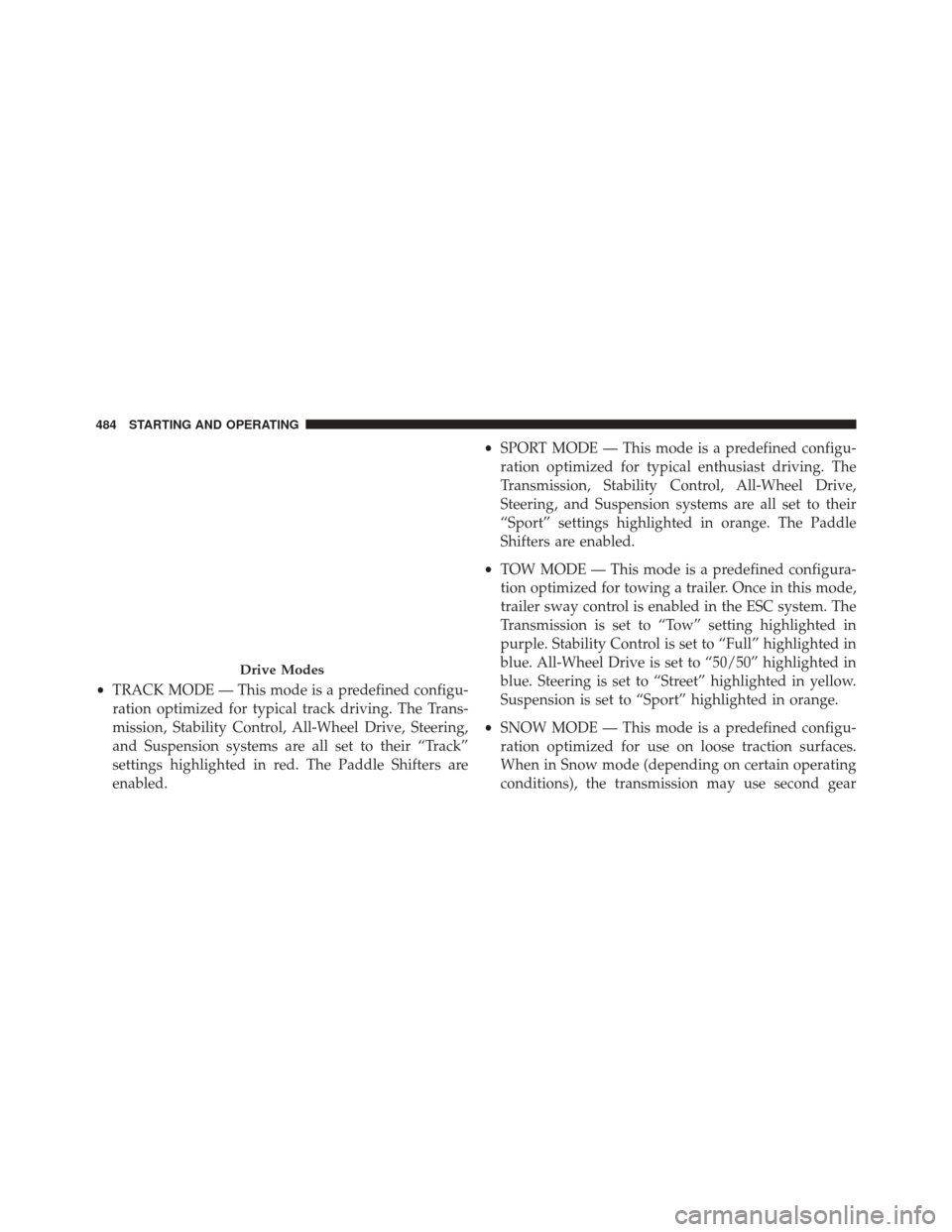
•TRACK MODE — This mode is a predefined configu-
ration optimized for typical track driving. The Trans-
mission, Stability Control, All-Wheel Drive, Steering,
and Suspension systems are all set to their “Track”
settings highlighted in red. The Paddle Shifters are
enabled. •
SPORT MODE — This mode is a predefined configu-
ration optimized for typical enthusiast driving. The
Transmission, Stability Control, All-Wheel Drive,
Steering, and Suspension systems are all set to their
“Sport” settings highlighted in orange. The Paddle
Shifters are enabled.
• TOW MODE — This mode is a predefined configura-
tion optimized for towing a trailer. Once in this mode,
trailer sway control is enabled in the ESC system. The
Transmission is set to “Tow” setting highlighted in
purple. Stability Control is set to “Full” highlighted in
blue. All-Wheel Drive is set to “50/50” highlighted in
blue. Steering is set to “Street” highlighted in yellow.
Suspension is set to “Sport” highlighted in orange.
• SNOW MODE — This mode is a predefined configu-
ration optimized for use on loose traction surfaces.
When in Snow mode (depending on certain operating
conditions), the transmission may use second gear
Drive Modes
484 STARTING AND OPERATING
Page 489 of 723
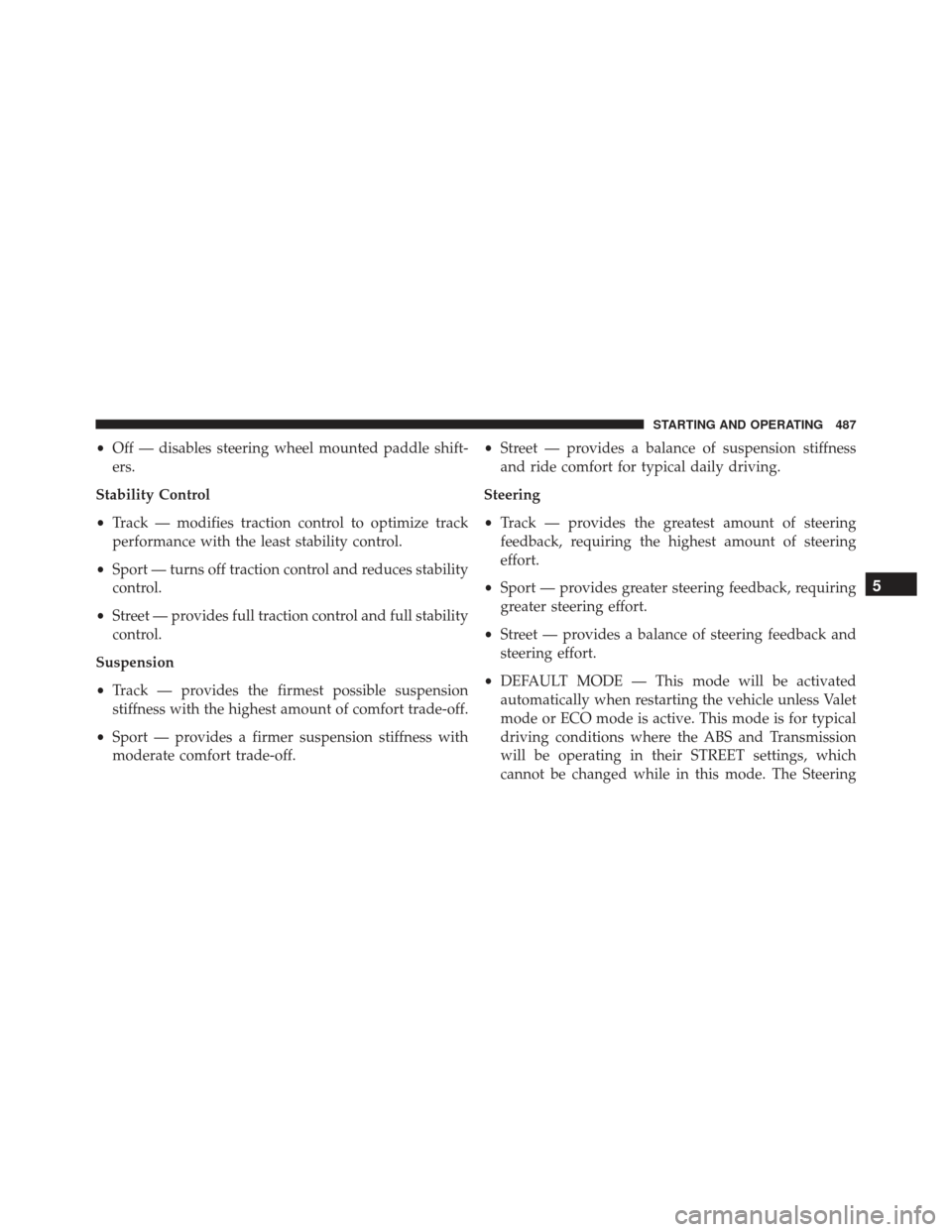
•Off — disables steering wheel mounted paddle shift-
ers.
Stability Control
• Track — modifies traction control to optimize track
performance with the least stability control.
• Sport — turns off traction control and reduces stability
control.
• Street — provides full traction control and full stability
control.
Suspension
• Track — provides the firmest possible suspension
stiffness with the highest amount of comfort trade-off.
• Sport — provides a firmer suspension stiffness with
moderate comfort trade-off. •
Street — provides a balance of suspension stiffness
and ride comfort for typical daily driving.
Steering
• Track — provides the greatest amount of steering
feedback, requiring the highest amount of steering
effort.
• Sport — provides greater steering feedback, requiring
greater steering effort.
• Street — provides a balance of steering feedback and
steering effort.
• DEFAULT MODE — This mode will be activated
automatically when restarting the vehicle unless Valet
mode or ECO mode is active. This mode is for typical
driving conditions where the ABS and Transmission
will be operating in their STREET settings, which
cannot be changed while in this mode. The Steering
5
STARTING AND OPERATING 487
Page 491 of 723
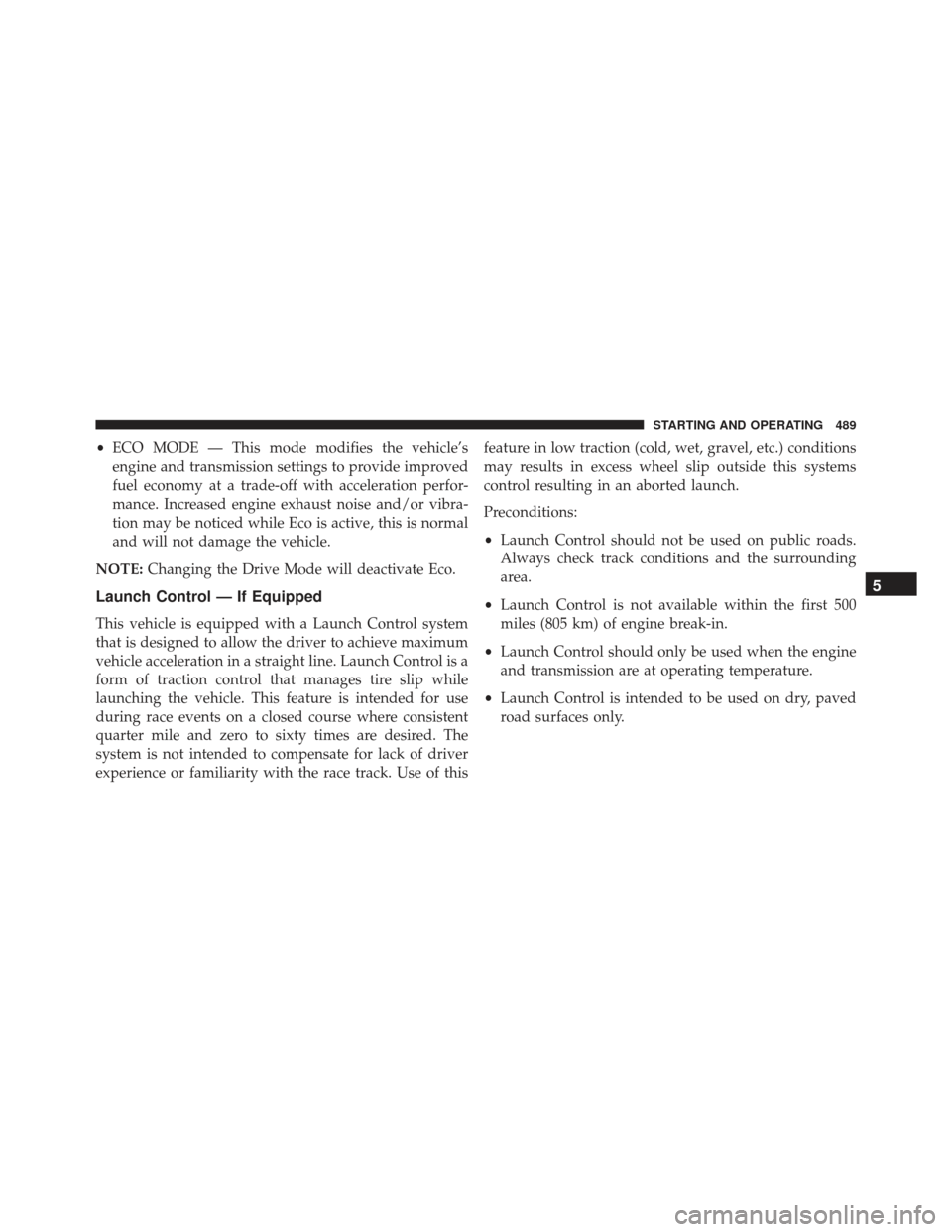
•ECO MODE — This mode modifies the vehicle’s
engine and transmission settings to provide improved
fuel economy at a trade-off with acceleration perfor-
mance. Increased engine exhaust noise and/or vibra-
tion may be noticed while Eco is active, this is normal
and will not damage the vehicle.
NOTE: Changing the Drive Mode will deactivate Eco.
Launch Control — If Equipped
This vehicle is equipped with a Launch Control system
that is designed to allow the driver to achieve maximum
vehicle acceleration in a straight line. Launch Control is a
form of traction control that manages tire slip while
launching the vehicle. This feature is intended for use
during race events on a closed course where consistent
quarter mile and zero to sixty times are desired. The
system is not intended to compensate for lack of driver
experience or familiarity with the race track. Use of this feature in low traction (cold, wet, gravel, etc.) conditions
may results in excess wheel slip outside this systems
control resulting in an aborted launch.
Preconditions:
•
Launch Control should not be used on public roads.
Always check track conditions and the surrounding
area.
• Launch Control is not available within the first 500
miles (805 km) of engine break-in.
• Launch Control should only be used when the engine
and transmission are at operating temperature.
• Launch Control is intended to be used on dry, paved
road surfaces only.
5
STARTING AND OPERATING 489
Page 492 of 723
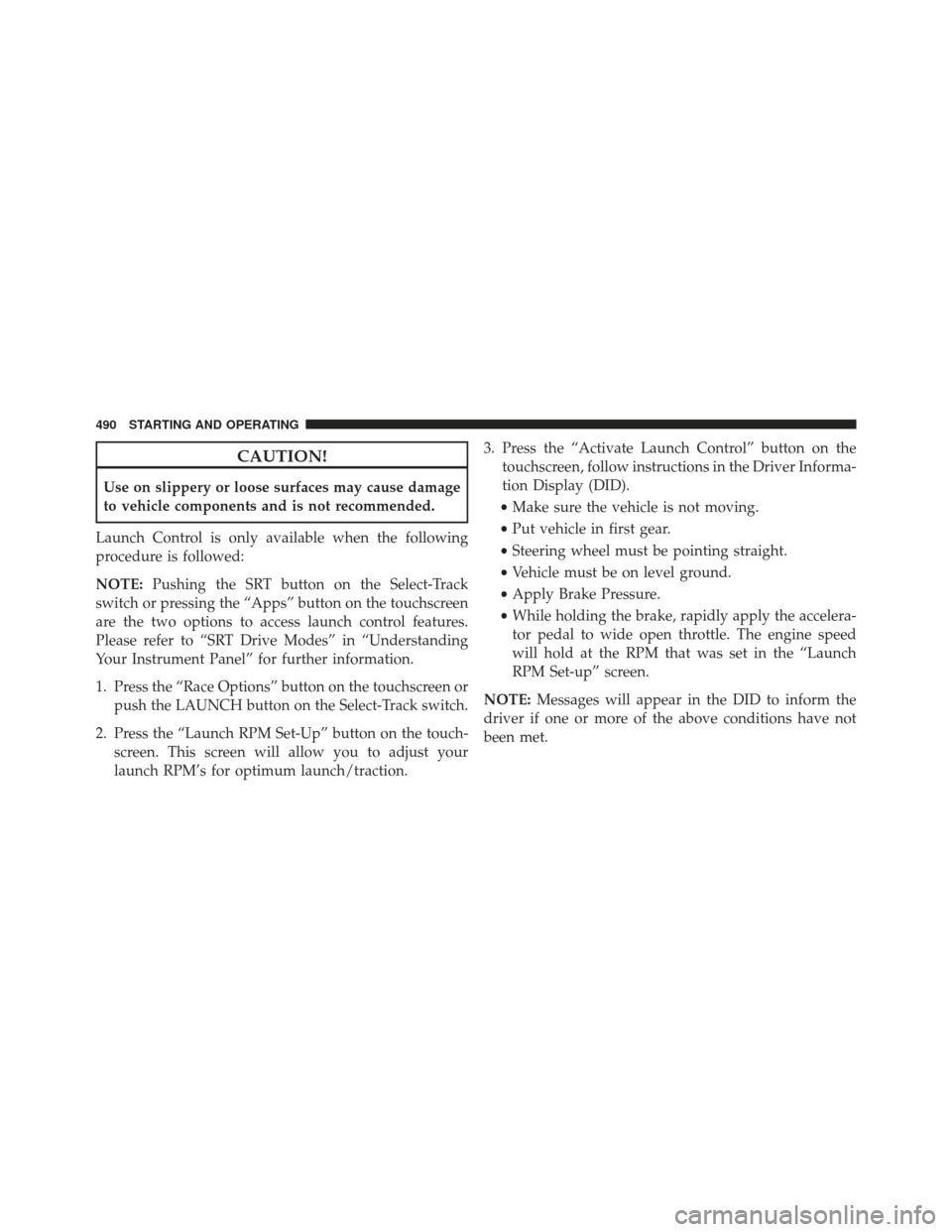
CAUTION!
Use on slippery or loose surfaces may cause damage
to vehicle components and is not recommended.
Launch Control is only available when the following
procedure is followed:
NOTE: Pushing the SRT button on the Select-Track
switch or pressing the “Apps” button on the touchscreen
are the two options to access launch control features.
Please refer to “SRT Drive Modes” in “Understanding
Your Instrument Panel” for further information.
1. Press the “Race Options” button on the touchscreen or push the LAUNCH button on the Select-Track switch.
2. Press the “Launch RPM Set-Up” button on the touch- screen. This screen will allow you to adjust your
launch RPM’s for optimum launch/traction. 3. Press the “Activate Launch Control” button on the
touchscreen, follow instructions in the Driver Informa-
tion Display (DID).
• Make sure the vehicle is not moving.
• Put vehicle in first gear.
• Steering wheel must be pointing straight.
• Vehicle must be on level ground.
• Apply Brake Pressure.
• While holding the brake, rapidly apply the accelera-
tor pedal to wide open throttle. The engine speed
will hold at the RPM that was set in the “Launch
RPM Set-up” screen.
NOTE: Messages will appear in the DID to inform the
driver if one or more of the above conditions have not
been met.
490 STARTING AND OPERATING
Page 493 of 723
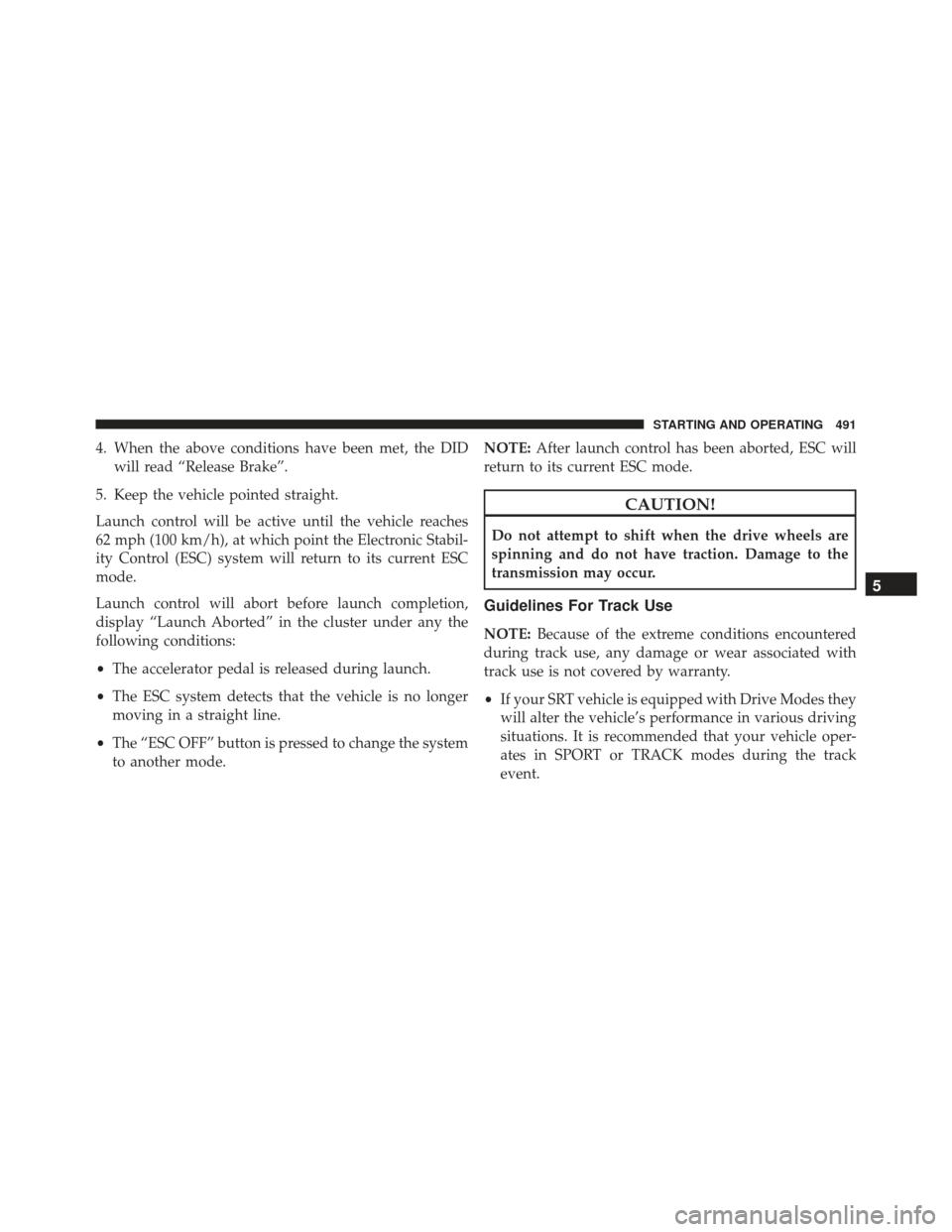
4. When the above conditions have been met, the DIDwill read “Release Brake”.
5. Keep the vehicle pointed straight.
Launch control will be active until the vehicle reaches
62 mph (100 km/h), at which point the Electronic Stabil-
ity Control (ESC) system will return to its current ESC
mode.
Launch control will abort before launch completion,
display “Launch Aborted” in the cluster under any the
following conditions:
• The accelerator pedal is released during launch.
• The ESC system detects that the vehicle is no longer
moving in a straight line.
• The “ESC OFF” button is pressed to change the system
to another mode. NOTE:
After launch control has been aborted, ESC will
return to its current ESC mode.
CAUTION!
Do not attempt to shift when the drive wheels are
spinning and do not have traction. Damage to the
transmission may occur.
Guidelines For Track Use
NOTE: Because of the extreme conditions encountered
during track use, any damage or wear associated with
track use is not covered by warranty.
• If your SRT vehicle is equipped with Drive Modes they
will alter the vehicle’s performance in various driving
situations. It is recommended that your vehicle oper-
ates in SPORT or TRACK modes during the track
event.
5
STARTING AND OPERATING 491
Page 510 of 723

and stability. A feature of the TCS, Brake Limited Differ-
ential (BLD), functions similar to a limited slip differen-
tial and controls the wheel spin across a driven axle. If
one wheel on a driven axle is spinning faster than the
other, the system will apply the brake of the spinning
wheel. This will allow more engine torque to be applied
to the wheel that is not spinning. BLD may remain
enabled even if TCS and ESC are in a reduced mode.
Electronic Stability Control (ESC)
This system enhances directional control and stability of
the vehicle under various driving conditions. ESC cor-
rects for oversteering or understeering of the vehicle by
applying the brake of the appropriate wheel(s) to assist in
counteracting the oversteer or understeer condition. En-
gine power may also be reduced to help the vehicle
maintain the desired path.
ESC uses sensors in the vehicle to determine the vehicle
path intended by the driver and compares it to the actualpath of the vehicle. When the actual path does not match
the intended path, ESC applies the brake of the appro-
priate wheel to assist in counteracting the oversteer or
understeer condition.
•
Oversteer - when the vehicle is turning more than
appropriate for the steering wheel position.
• Understeer - when the vehicle is turning less than
appropriate for the steering wheel position.
The “ESC Activation/Malfunction Indicator Light” lo-
cated in the instrument cluster will start to flash as soon
as the ESC system becomes active. The “ESC Activation/
Malfunction Indicator Light” also flashes when the TCS
is active. If the “ESC Activation/Malfunction Indicator
Light” begins to flash during acceleration, ease up on the
accelerator and apply as little throttle as possible. Be sure
to adapt your speed and driving to the prevailing road
conditions.
508 STARTING AND OPERATING
Page 512 of 723

ESC Operating Modes
NOTE:Depending upon model and mode of operation,
the ESC system may have multiple operating modes.
ESC On
This is the normal operating mode for the ESC. When-
ever the vehicle is started, the ESC system will be in this
mode. This mode should be used for most driving
conditions. Alternate ESC modes should only be used for
specific reasons as noted in the following paragraphs.
Partial Off
The “Partial Off” mode is intended for times when a
more spirited driving experience is desired. This mode
may modify TCS and ESC thresholds for activation,
which allows for more wheel spin than normally al-
lowed. This mode may be useful if the vehicle becomes
stuck. To enter the “Partial Off” mode, momentarily push the
“ESC Off” switch and the “ESC Off Indicator Light” will
illuminate. To turn the ESC on again, momentarily push
the “ESC Off” switch and the “ESC Off Indicator Light”
will turn off.
NOTE:
For vehicles with multiple partial ESC modes a
momentary button push will toggle the ESC mode.
Multiple momentary button pushed may be required to
return to ESC On.
NOTE:
• When in “Partial Off” mode, the TCS functionality of
ESC, (except for the limited slip feature described in
the TCS section), has been disabled and the “ESC Off
Indicator Light” will be illuminated. When in “Partial
Off” mode, the engine power reduction feature of TCS
is disabled, and the enhanced vehicle stability offered
by the ESC system is reduced.
510 STARTING AND OPERATING
Page 513 of 723

•Trailer Sway control (TSC) is disabled when the ESC
system is in the “Partial Off” mode.
Full Off – If Equipped
This mode is intended for off-highway or off-road use
only and should not be used on any public roadways. In
this mode, TCS and ESC features are turned OFF. To enter
the “Full Off” mode, push and hold the “ESC Off” switch
for five seconds while the vehicle is stopped with the
engine running. After five seconds, a chime will sound,
the “ESC Off Indicator Light” will illuminate, and the
“ESC OFF” message will display in the Electronic Vehicle
Information Center (EVIC). To turn ESC ON again,
momentarily push the “ESC Off” switch.
NOTE: System may switch from ESC Full Off to Partial
mode when vehicle exceeds a predetermined speed.
When the vehicle speed slows below the predetermined
speed the system will return to ESC Full Off. ESC modes may also be affected by drive modes – if
equipped.
WARNING!
•
In the ESC “Full Off” mode, the engine torque
reduction and stability features are disabled.
Therefore, enhanced vehicle stability offered by
the ESC system is unavailable. In an emergency
evasive maneuver, the ESC system will not engage
to assist in maintaining stability. “ESC Off” mode
is intended for off-highway or off-road use only.
ESC Activation/Malfunction Indicator Light and
ESC OFF Indicator Light
The “ESC Activation/Malfunction Indicator
Light” in the instrument cluster will come on
when the ignition switch is turned to the ON
5
STARTING AND OPERATING 511